|
|
 |
Portfolio |
 |
-Capacity
Portfolio
|
  |
 |
We consider here a portfolio that consists
of the machines used for processing in a manufacturing
or service system. The system consists of several stations
where processing takes place and where finished or intermediate
products are withdrawn and sold. Sales cause flow through
one or more stations. To handle that flow machines of
fixed capacity must be purchased. Machines require investment
and incur operating costs. One measure for the system
is the profit which is the revenue from sales less the
costs of manufacture. The model will include a constraint
on minimum profit. The model will also include a budget
constraint on the total initial investment.
As the amount of flow increases through a fixed capacity
machine, congestion grows in a nonlinear manner. This
is best illustrated by the queues of a queuing network.
We consider congestion in our model as the objective to
be minimized.
We build a nonlinear-integer mathematical programming
model that considers congestion, profit and investment.
The data for the problem is described on this page. The
mathematical programming model is described on the next
page. To create a model choose Capacity from
the Portfolio menu. |
The dialog below accepts the structural data for the system.
Projects will provide capacity for stations that carry flow.
The number of projects must be at least equal to the number
of stations. The MARR is the minimum acceptable rate of return
used for financial calculations. This must be expressed in terms
of the time interval specified on the dialog, weeks in the example.
The drive option, Push or Pull, is selected
by the buttons on the right of the dialog.
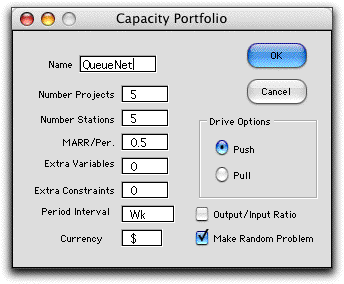
In the following sections, we describe the various
data items required by the analysis.
System Drive and Structure
| |
The drive and structure options
for a system are also used for inventory
analysis, process
flow analysis and queuing
networks. For more detail, please see these discussions.
We provide here only a brief survey.
The simplest pull and push systems have all stations
arranged in a line as shown at the left. For a pull system,
flow is pulled from the system at the station outputs.
Flow pulled from station 5 passes through all the preceding
stations. Although the figure shows output only at station
5, the models allow flow to be pulled from any station.
Pull systems usually represent manufacturing systems where
the products are sold after they are pulled.
For a push system, flow is pushed into the system at
the station inputs. Flow pushed into station 1 passes
through all the following stations. Although the figure
shows input only at station 1, the models allow flow to
be pushed into any station. Push systems usually represent
service systems where customers receive a variety of services
after they enter the system. |
|
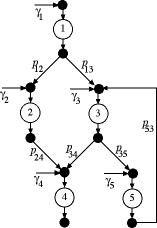
Push Network |
More complicated systems are described as networks.The
figure shows the push system used by the example. The
structure of the system is described by the square transfer
matrix P.

For some applications the components of the matrix represent
probabilities, but more generally the value  is the flow passed to station j per unit of flow
passing through station i. The value of
is the flow passed to station j per unit of flow
passing through station i. The value of  may be any positive quantity and rows of the matrix need
not sum to 1. The matrix used for the example is below.
Note that the flow at station 1 is split to go to stations
2 and 3. The last row indicates that 10% of the flow leaving
station 5 is returned to station 3 for reprocessing.
may be any positive quantity and rows of the matrix need
not sum to 1. The matrix used for the example is below.
Note that the flow at station 1 is split to go to stations
2 and 3. The last row indicates that 10% of the flow leaving
station 5 is returned to station 3 for reprocessing.
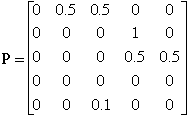
Flow may enter at any station, but it is
not necessary to define where the flow leaves. Given the
entering flows, the flow in each station is determined
by the solution of a set of equations involving P. |
|
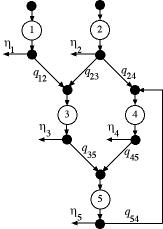
Pull Network |
The figure at the left shows a pull system
with 5 stations. The network structure of the pull system
is described by the matrix Q. The component
 is the flow leaving node i per unit of flow passing
through node j. Again the components of the matrix
must be nonnegative.
is the flow leaving node i per unit of flow passing
through node j. Again the components of the matrix
must be nonnegative.

An example is provided by the matrix below.
The columns of Q describe the
inputs to a station. For example, column 5 indicates that
for every unit passing through station 5, one unit must
pass through each of stations 3 and 4. This is typical
for an assembly station.
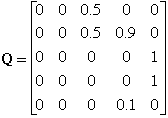
For the pull system, the flows through all
stations are governed by the flows pulled from the system.
The solution of a set of linear equations involving Q
determines the station flows. |
The specification of either P
or Q is part of the data for the Capacity
Portfolio model.
|
Portfolio Data
 |
After specifying the
model parameters and selecting the drive option, the program
constructs a math programming model based on a variety of data
that must be entered on the forms provided on the worksheet.
The data area is located immediately below the constraint area
of the model. For the example, this is row 30 of the worksheet.
Three data items must be entered to describe the general features
of the portfolio: the MARR (H31), the minimum value of the present
worth (L32), and the amount of the budget available (L33). The
dialog specifies the time interval as one week (Wk). The MARR
is the minimum required rate of return per week. The value entered
represents roughly 25% per year. We will have more to say about
the time interval selection later. The other cells on the form
below are filled by equations (H32, H33) or by algorithm computations
(L31).

|
Project Data |
| |
Project data appears in the rows
following the Portfolio data. There must be at least one project
for each station. The data describing a project involves providing
a single machine. Part of the problem is to determine the optimum
number of machines.
A machine processes flow, and the data for one machine is shown
in each column. Time dimensioned quantities are given in the
time interval measure, week for the example. Each machine requires
a investment expenditure at time 0 given in row 37. In every
time interval during the machine's life there is an operating
cost expenditure as given in row 38. Row 39 gives the salvage
value of the machine at the end of its life. We have chosen
0 for all projects. The machine lives are specified in row 40.
Since one week is the time interval for the example, the quantities
in row 40 are in weeks. The financial quantities are combined
using Excel financial functions to obtain a net cost per week
in row 46. For a normal project the Investment, operating cost
and salvage value are entered as positive numbers, although,
investment and operating costs are cash outflows and the salvage
value is a cash inflow.
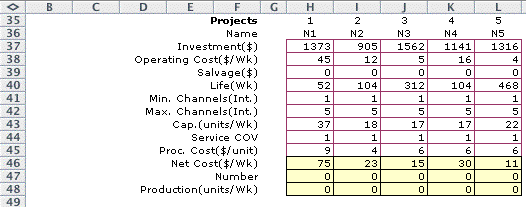
The math program will select the number of machines of each
type that optimizes the objective function. The minimum and
maximum number of machines (servers for a queue station) are
given in rows 41 and 42. The capacity, entered in row 43, is
the amount flow that can be handled by a single machine at a
station. For example, the N1 machine has a capacity of 37. If
the flow through station 1 is greater than 37, certainly more
than one of machine N1 must be provided.
The model will determine congestion with formulas from queuing
theory. These formulas are based on the assumptions that the
times between arrivals and the service times for stations are
exponentially distributed. There are adjustments to these formulas
when the service time variability is reduced. The Coefficient
of Variation (COV) is the standard deviation of the service
time divided by the mean service time. For exponential distributions
the COV is 1, however, we provide the data item on row 44 to
allow other values. Finally there is a component of operating
cost that is linearly related to the flow through the machine.
We call this the Processing Cost and enter values of the cost
per unit in row 45.
Rows 47 and 48 hold values provided by the solution of the
model. These values are 0 before the problem has been solved. |
Station Data |
| |
The stations have data in columns
H through L starting for the example in row 50. The unit profit
in row 52 is unit sales revenue less raw materials cost. The
sales volumes at the stations are variables in the model and
the minimum and maximum sales are in rows 53 and 54. Recall
that sales are pushed into station inputs for a push system,
and sales are pulled from the outputs of the stations for pull
systems. Rather than process the flow at the station, we allow
the processing to be outsourced. The cost and WIP for outsourced
units are in rows 55 and 56. Rows 57 and 58 report the results
of the optimization and are initially 0.

|
Transfer Data |
| |
|
The transfer rates from one station to
the next are given by the entries in P
matrix starting at row 61. The example at the left is
represented by matrix below. The Augmented Matrix
is determined from the P matrix.
The inverse of the augmented matrix is used by the model
to compute the flow through the stations.
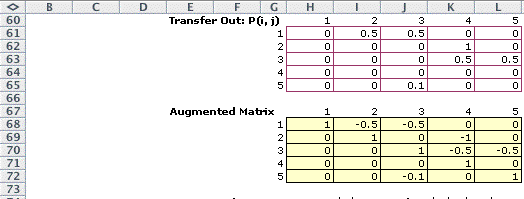
|
The model that uses this data is on the next page. |

|



